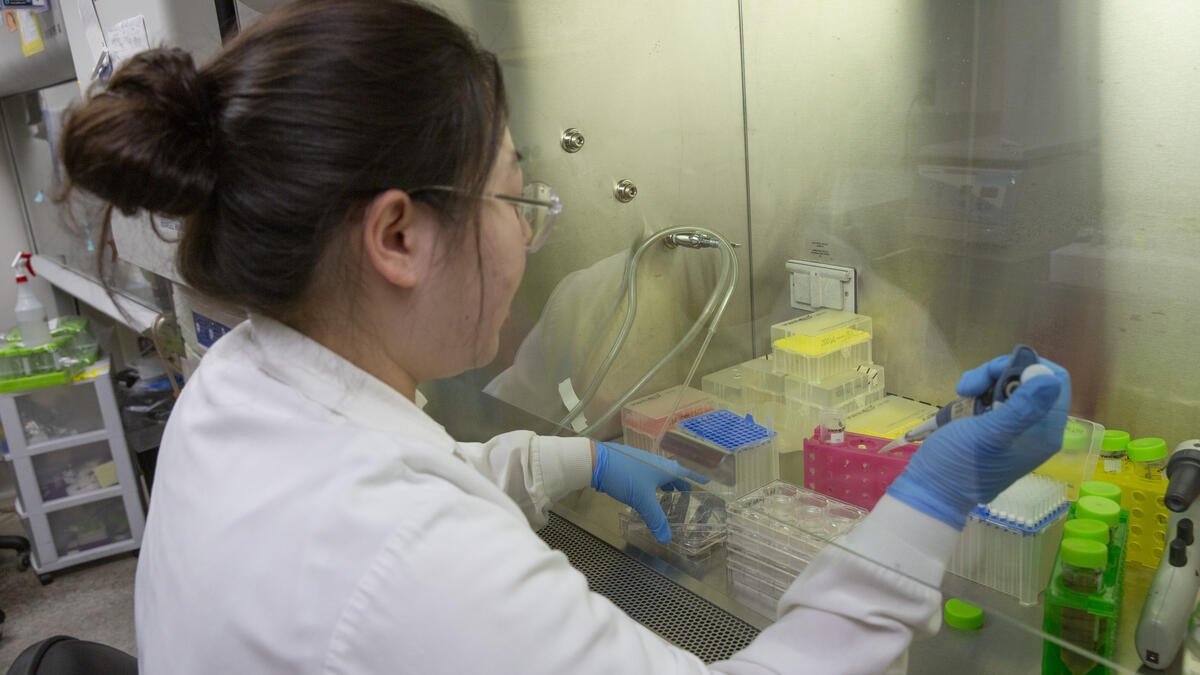Harnessing benefits of stem cells for heart regeneration

Michelle Jang, a biomedical engineering graduate student in the Ira A. Fulton Schools of Engineering at Arizona State University, works on using stem cell technology within conductive hydrogel solution. She is part of Mehdi Nikkhah’s lab team currently studying engineered heart tissues, or EHTs, to improve cell maturation and electrical properties. Photo by Allison Lyne/ASU
Mehdi Nikkhah, an associate professor of biomedical engineering in the Ira A. Fulton Schools of Engineering at Arizona State University, and his collaborators at Mayo Clinic in Arizona have been awarded a $2.7 million grant by the National Institutes of Health to research how stem cell engineering and tissue regeneration can aid in heart attack recovery.
The research will be conducted in collaboration with Wuqiang Zhu, a cardiovascular researcher and professor of biomedical engineering at Mayo Clinic.
Nikkhah and Zhu are exploring stem cell transplantation to repair and possibly regenerate damaged myocardium, or heart tissue. Their work is focused on the development of a new class of engineered heart tissues with the use of human-induced pluripotent stem cells, or hiPSCs, and has resulted in two published papers in ACS Biomaterials.
Understanding heart attacks
A heart attack, medically termed as a myocardial infarction, occurs when a coronary artery that sends blood and oxygen to the heart becomes obstructed. This blockage is often the result of an accumulation of fatty cholesterol-containing deposits, known as plaques, within the heart’s arteries.
When these plaques rupture, a cascade of events is initiated, leading to the formation of a blood clot. These blood clots can obstruct the artery, impeding blood flow to the heart muscle, thus triggering a heart attack.
“When someone has a heart attack, a portion of muscle tissue on the left ventricle, which pumps the blood throughout the whole body, is damaged,” Nikkhah says. “Over time, the other parts of the heart have to take on more workload, consequently leading to catastrophic heart failure.”
A team of biomedical engineers in the School of Biological and Health Systems Engineering, part of the Fulton Schools, and medical researchers at Mayo Clinic in Arizona are taking a novel step forward in using stem cell technology and regenerative medicine to aid in heart attack recovery.
Nikkhah is developing engineered heart tissues, or EHTs, with electrical properties to simulate the contraction function typically found within the native heart’s tissue.
He is integrating the EHTs with gold nanorods to enhance electrical conductivity among stem cells. Gold is a suitable material because it is conductive and nontoxic to human cells, making the nanorods safe for medical research and translational studies.
In the lab, Nikkhah’s team mixes the gold nanorods with a biocompatible hydrogel to form a tissue construct — a patch of stem cells — to rejuvenate damaged cardiac muscle tissue, offering a promising outcome for heart regeneration.
“After we generate the patch, we get the engineered hiPSCs from Dr. Zhu’s lab at Mayo Clinic,” Nikkhah says. “They seed the cells on the patch and look at their biological characterization, including cell proliferation, cell viability and gene expression analysis, to see how the cells respond to the conductive hydrogel.
“We have successfully used hiPSC-derived cardiomyocytes and cardiac fibroblasts to create beating heart tissues.”
The successful integration and proliferation of these cells can lead to the formation of new, healthy heart tissue, potentially reversing the damage caused by the heart attack and enhancing the recovery process.
Reprogrammed human stem cells have nearly limitless potential because they can be differentiated into various cell types. That means hiPSCs can also be used to construct capillaries and blood vessels, which are essential for restoring adequate blood flow and oxygen supply to the damaged areas of the heart.
This process involves the differentiation of hiPSCs into endothelial cells, which form the lining of blood vessels, thereby facilitating the reconstruction of the heart’s vascular network.
Michelle Jang, a graduate student in Nikkhah’s lab, is currently studying EHTs to improve cell maturation and observe its electrical properties.
“My engagement in this project showed a deep interest in how biomedical engineering technology and biology intersect to create new therapeutic possibilities in the field of regenerative medicine,” Jang says. “I’m excited to see how my current research will further evolve and potentially contribute valuable insights to biomedical research.”
Using these techniques, Nikkhah and Zhu can observe the capacity of programmed cells to regenerate damaged heart tissue. With continued advancement in regenerative medicine, there is potential for significant positive impact on outcomes for patients suffering from heart attacks.
More Science and technology

Stuck at the airport and we love it #not
Airports don’t bring out the best in people.Ten years ago, Ashwin Rajadesingan was traveling and had that thought. Today, he is an assistant professor at the University of Texas at Austin, but back…

ASU in position to accelerate collaboration between space, semiconductor industries
More than 200 academic, business and government leaders in the space industry converged in Tempe March 19–20 for the third annual Arizona Space Summit, a statewide effort designed to elevate…

A spectacular celestial event: Nova explosion in Northern Crown constellation expected within 18 months
Within the next year to 18 months, stargazers around the world will witness a dazzling celestial event as a “new” star appears in the constellation Corona Borealis, also known as the Northern Crown.…

